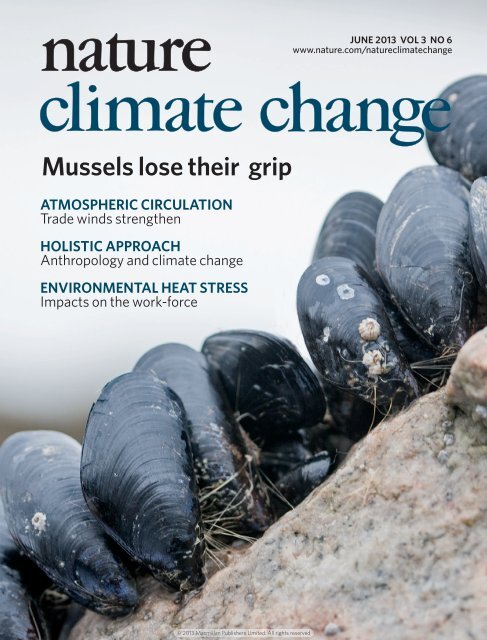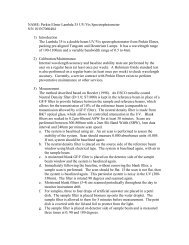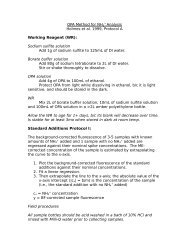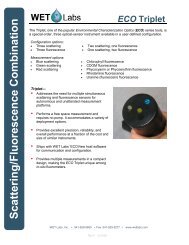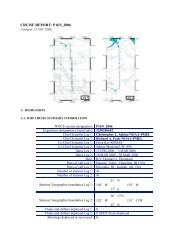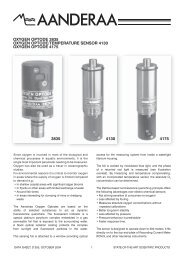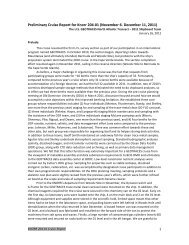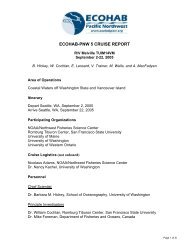Mussel byssus attachment weakened by ocean acidification
Mussel byssus attachment weakened by ocean acidification
Mussel byssus attachment weakened by ocean acidification
You also want an ePaper? Increase the reach of your titles
YUMPU automatically turns print PDFs into web optimized ePapers that Google loves.
JUNE 2013 VOL 3 NO 6<br />
www.nature.com/natureclimatechange<br />
<strong>Mussel</strong>s lose their grip<br />
ATMOSPHERIC CIRCULATION<br />
Trade winds strengthen<br />
HOLISTIC APPROACH<br />
Anthropology and climate change<br />
ENVIRONMENTAL HEAT STRESS<br />
Impacts on the work-force<br />
© 2013 Macmillan Publishers Limited. All rights reserved
LETTERS<br />
PUBLISHED ONLINE: 10 MARCH 2013 | DOI: 10.1038/NCLIMATE1846<br />
<strong>Mussel</strong> <strong><strong>by</strong>ssus</strong> <strong>attachment</strong> <strong>weakened</strong> <strong>by</strong><br />
<strong>ocean</strong> <strong>acidification</strong><br />
Michael J. O’Donnell 1 *, Matthew N. George 1,2 and Emily Carrington 1,2<br />
Biomaterials connect organisms to their environments. Their<br />
function depends on biological, chemical and environmental<br />
factors, both at the time of creation and throughout the life of<br />
the material. Shifts in the chemistry of the <strong>ocean</strong>s driven <strong>by</strong><br />
anthropogenic CO 2 (termed <strong>ocean</strong> <strong>acidification</strong>) have profound<br />
implications for the function of critical materials formed<br />
under these altered conditions. Most <strong>ocean</strong> <strong>acidification</strong><br />
studies have focused on one biomaterial (secreted calcium<br />
carbonate), frequently using a single assay (net rate of<br />
calcification) to quantify whether reductions in environmental<br />
pH alter how organisms create biomaterials 1 . Here, we examine<br />
biological structures critical for the success of ecologically and<br />
economically important bivalve molluscs. One non-calcified<br />
material, the proteinaceous <strong>by</strong>ssal threads that anchor mytilid<br />
mussels to hard substrates, exhibited reduced mechanical<br />
performance when secreted under elevated p CO2 conditions,<br />
whereas shell and tissue growth were unaffected. Threads<br />
made under high p CO2 (>1,200 µatm) were weaker and<br />
less extensible owing to compromised <strong>attachment</strong> to the<br />
substratum. According to a mathematical model, this reduced<br />
<strong>by</strong>ssal fibre performance, decreasing individual tenacity <strong>by</strong><br />
40%. In the face of <strong>ocean</strong> <strong>acidification</strong>, <strong>weakened</strong> <strong>attachment</strong><br />
presents a potential challenge for suspension-culture mussel<br />
farms and for intertidal communities anchored <strong>by</strong> mussel beds.<br />
Coastal regions host rich and diverse communities of organisms<br />
and are the primary location of contact between human activities<br />
and the <strong>ocean</strong>s. Understanding the biological consequences of<br />
environmental changes in these areas is critical to predicting<br />
what ecosystems will look like in the future. As human activities<br />
release CO 2 to the atmosphere, and that CO 2 dissolves into the<br />
surface <strong>ocean</strong>, seawater pH declines, a process known as <strong>ocean</strong><br />
<strong>acidification</strong> 2 . This presents a new set of challenges to organisms<br />
living on rocky shores. Open-<strong>ocean</strong> systems are predicted to<br />
experience declines of ∼0.2 pH units over the twenty-first century.<br />
Nearshore systems already experience lower and more variable<br />
pH water owing to coastal upwelling and high levels of biological<br />
activity 3 . Over the past 20 years, worldwide research efforts have<br />
discovered a wide variety of organisms and biological processes<br />
that seem susceptible to reduced pH conditions. Corals, the earliest<br />
and perhaps best studied group, exhibit lower growth of calcified<br />
structures 4 . Echinoderms, particularly at vulnerable larval stages,<br />
experience lower growth and altered stress responses 5 . The relatively<br />
few studies on mussels have shown slower growth 6 , reduced<br />
immune response 7 and slower larval growth with weaker shells 8 .<br />
Mytilid mussels are both ecologically and economically important.<br />
They are competitive dominants for space on rocky shores<br />
worldwide, largely owing to their ability to adhere to bare rock<br />
with <strong>by</strong>ssal threads. <strong>Mussel</strong>s also support a worldwide aquaculture<br />
industry worth more than US$1.5 billion in 2009 9 . The <strong>by</strong>ssal<br />
threads of mytilid mussels are formed from collagen-like liquid<br />
precursors that are secreted into a groove in the foot and polymerize<br />
into a stiff yet extensible thread 10,11 . Byssal threads are divided<br />
into three distinct regions: a highly extensible proximal end, a<br />
distal portion that is initially stiff, but yields (plastically deforms)<br />
before stiffening again, and a plaque that adheres the thread to the<br />
substratum 12 . Previous studies have shown that threads typically<br />
fail at the plaque or proximal regions 10,12 . The chemical properties<br />
of <strong>by</strong>ssal threads have been well documented as well 11,13,14 . Byssal<br />
threads include a high concentration of the modified amino acid<br />
3,4-dihydroxyphenylalanine (Dopa) and histidine–metal crosslinkages,<br />
which seem to play critical roles in surface adhesion and<br />
self-healing following deformation 11,15 . These chemical functions<br />
are known to depend on pH, including shifts in the His–metal<br />
crosslinks responsible for some of the thread stiffness properties 11 ,<br />
motivating interest in how this biomaterial might be affected <strong>by</strong><br />
shifts in <strong>ocean</strong> chemistry. Importantly, external seawater chemistry<br />
may mediate <strong>by</strong>ssal thread formation in a manner that is not<br />
detectable using genomic, transcriptomic or proteomic techniques;<br />
we report here effects of elevated CO 2 on the end phenotype.<br />
In addition to their primary chemistry, <strong>by</strong>ssal strength is<br />
known to be affected <strong>by</strong> other aspects of the environment and<br />
mussel physiology, including seasonal effects and tradeoffs with<br />
reproductive condition 16 . We looked at several aspects of mussel<br />
physiology including growth, general condition and reproductive<br />
status to explore possible linkages between condition and <strong><strong>by</strong>ssus</strong><br />
strength. Making ecomechanical predictions (sensu refs 17,18)<br />
about future communities requires examining the response<br />
function of a variety of biological parameters to a wide range<br />
of p CO2<br />
scenarios.<br />
As the p CO2<br />
in the water increased from 300 to 1,500 µatm<br />
(pH decline from 8.0 to 7.5 on the total scale, within the range<br />
observed in mussel beds 19 ), individual threads broke at lower forces<br />
and extensions (Fig. 1a). This result was driven entirely <strong>by</strong> plaque<br />
weakening (Fig. 2a); mechanical performance was unchanged in the<br />
proximal (Fig. 2b) and distal regions (not shown). Consequently,<br />
the most probable location of failure moved from the proximal<br />
region to the plaque in more acidic treatments (Fig. 2c). Although<br />
there was no effect of p CO2<br />
treatment on the force at which the distal<br />
region yielded (Fig. 2a), overall thread extensibility decreased at the<br />
higher p CO2<br />
treatments (Fig. 1b) because the plaque frequently failed<br />
before the distal region fully yielded (Figs 1c and 2a).<br />
As extensible <strong>by</strong>ssal threads spread hydrodynamic loads evenly<br />
across many threads of the <strong><strong>by</strong>ssus</strong> 12 , reduced thread strength<br />
and extensibility combine to limit the tenacity, or ability of<br />
1 Friday Harbor Laboratories, University of Washington, 620 University Road, Friday Harbor, Washington 98250, USA, 2 Department of Biology, University<br />
of Washington, Seattle, Washington 98195, USA. *e-mail: mooseo@uw.edu.<br />
NATURE CLIMATE CHANGE | VOL 3 | JUNE 2013 | www.nature.com/natureclimatechange 587<br />
© 2013 Macmillan Publishers Limited. All rights reserved
LETTERS<br />
NATURE CLIMATE CHANGE DOI: 10.1038/NCLIMATE1846<br />
a<br />
0.6<br />
Thread strength<br />
b<br />
1.0<br />
Extensibility<br />
0.5<br />
0.8<br />
Force to break (N)<br />
0.4<br />
0.3<br />
0.2<br />
Max strain<br />
0.6<br />
0.4<br />
0.1<br />
0.2<br />
c<br />
Force (N)<br />
0.0<br />
0.0<br />
0.4<br />
more extensible<br />
Weaker and<br />
at low p CO2 10<br />
less extensible<br />
200 400 600 800 1,200 1,600<br />
200 400 600 800 1,200 1,600<br />
p CO2<br />
(µatm)<br />
p CO2<br />
(µatm)<br />
0.6<br />
d<br />
Example pulls<br />
15 Predicted tenacity<br />
0.5<br />
Normal<br />
Stronger and<br />
0.3<br />
at high p CO2<br />
Force (N)<br />
0.2<br />
5<br />
Parallel<br />
0.1<br />
0.0<br />
0.0 0.1 0.2 0.3 0.4 0.5 0.6 0.7<br />
Strain<br />
0<br />
200 400 600 800 1,200 1,600<br />
p CO2<br />
(µatm)<br />
Figure 1 | Performance of <strong>by</strong>ssal threads as a function of p CO2 treatment. a,b, Whole threads are significantly weaker (mean, n = 8±s.e.m., breaking<br />
force = 0.31−3.55×10 −11∗ (p CO2 ) 3 , p < 0.05; a), and are significantly less extensible with increased p CO2 (mean, n = 8±s.e.m., breaking<br />
strain = 0.07−8.11×10 −11∗ (p CO2 ) 3 , p < 0.01; b). c, Representative tensile tests of whole threads showing distal region yield and subsequent failure when<br />
p CO2 < 1,200 µatm (dashed line). At high p CO2 , threads more often fail in the plaque region before the distal region fully yields (solid line). d, Predicted<br />
model of whole-animal tenacity when pulled normal (triangles) or parallel (squares) to substratum. In both cases, there is a significant decline in tenacity<br />
as a function of p CO2 (p < 0.05; normal: 41% decline, parallel: 35% decline).<br />
a 0.6<br />
b 0.6<br />
c 100<br />
Plaque<br />
Proximal<br />
Force to break (N)<br />
0.5<br />
0.4<br />
0.3<br />
0.2<br />
Distal yield<br />
0.1<br />
Force to break (N)<br />
0.5<br />
0.4<br />
0.3<br />
0.2<br />
Distal yield<br />
0.1<br />
Failure location (%)<br />
80<br />
60<br />
40<br />
20<br />
Plaque<br />
Proximal<br />
0.0<br />
0.0<br />
0<br />
200 600 1,000 1,400 200 600 1,000 1,400 200 600 1,000 1,400<br />
p CO2<br />
(µatm) p CO2<br />
(µatm) p CO2<br />
(µatm)<br />
Figure 2 | Performance of <strong>by</strong>ssal thread components. a,b, Plaques weaken with increased p CO2 (mean, n = 8±s.e.m. force = 0.39−5.70×10 −11∗ (p CO2 ) 3 ,<br />
p < 0.05; a), whereas the structural integrity of the proximal region is maintained (symbols are mean±s.e.m., n = 8, line is pooled mean, p = 0.73; b).<br />
Distal yield force (represented <strong>by</strong> shaded region of mean±s.d.) was also unaffected <strong>by</strong> p CO2 (p = 0.90). c, At lower p CO2 , failure commonly occurs in<br />
either the proximal region (dark shading) or plaque (light shading). At high p CO2 (>1,200 µatm) there is a higher likelihood of plaque failure.<br />
588 NATURE CLIMATE CHANGE | VOL 3 | JUNE 2013 | www.nature.com/natureclimatechange<br />
© 2013 Macmillan Publishers Limited. All rights reserved
NATURE CLIMATE CHANGE DOI: 10.1038/NCLIMATE1846<br />
LETTERS<br />
Table 1 | Water conditions during 20-day experiment.<br />
p CO2 target (µatm) Temp ( ◦ C) pH (total scale) Totally alkalinity<br />
(µmol kg −1 )<br />
Total carbon<br />
(µmol kg −1 )<br />
p CO2 (µatm) Ω Ar Ω Ca<br />
300 10.8 ± 0.6 8.14 ± 0.02 2,081 1,896 ± 23 299 ± 8 2.0 3.2<br />
500 10.6 ± 0.6 8.00 ± 0.02 2,086 1,955 ± 12 432 ± 15 1.5 2.4<br />
600 10.2 ± 0.8 7.89 ± 0.04 2,084 1,993 ± 11 575 ± 16 1.2 1.9<br />
800 10.2 ± 0.6 7.79 ± 0.05 2,083 2,020 ± 20 736 ± 37 1.0 1.5<br />
1,000 10.4 ± 0.7 7.70 ± 0.06 2,085 2,045 ± 19 908 ± 89 0.8 1.3<br />
1,100 10.5 ± 0.5 7.64 ± 0.04 2,082 2,058 ± 16 1,057 ± 95 0.7 1.1<br />
1,200 10.1 ± 0.6 7.60 ± 0.02 2,088 2,077 ± 14 1,180 ± 119 0.6 1.0<br />
1,300 10.4 ± 0.6 7.55 ± 0.04 2,086 2,088 ± 17 1,322 ± 45 0.6 0.9<br />
1,500 10.4 ± 0.7 7.50 ± 0.01 2,087 2,102 ± 13 1,498 ± 37 0.5 0.8<br />
Temperature is average ±s.d. of daily measures. pH is average of 1-min readings from Durafet electrodes. pH deviation provides an estimate of the accuracy of the measurement technique, and represents<br />
the average deviation between recorded pH and pH calculated from six TA and T C measurements pairs. TA was estimated from daily salinity as described in text. T C , p CO2 , Ω Ar and Ω Ca (the saturation<br />
states of aragonite and calcite, respectively) are averages ±s.d. estimated daily from TA and recorded pH using CO2calc. p CO2 deviation provides a summary estimate of chemical variability throughout<br />
the experiment; it includes the short-term fluctuations in pH and longer-term changes in alkalinity. Water was undersaturated with respect to aragonite in five of the treatments, and with respect to calcite<br />
in the highest two treatments.<br />
a mussel to remain on the shore, under wave-induced stress.<br />
We employed the model from ref. 12 to estimate the effect of<br />
increased p CO2<br />
on mussel tenacity. We considered the simple case<br />
of a mussel with 50 threads, each with average length, strength<br />
and extensibility for a given treatment group. When the model<br />
mussel was pulled parallel or normal to the substratum, tenacity<br />
decreased 35–41% over the range of p CO2<br />
levels tested (Fig. 1d).<br />
This ecomechanical analysis suggests that <strong>ocean</strong> <strong>acidification</strong>, <strong>by</strong><br />
changing the properties of <strong>by</strong>ssal thread structures, will reduce<br />
mussel tenacity and increase dislodgement risk in natural habitats<br />
and commercial suspension cultures 20,21 .<br />
None of the other physiological metrics examined varied across<br />
the range of p CO2<br />
levels tested. All animals exhibited positive growth<br />
during the 20-day experimental period and there was no trend with<br />
p CO2<br />
treatment (Supplementary Table S1). Given the short-term<br />
nature of this exposure, this is not surprising. The lack of pattern in<br />
body metrics suggests that the effect we document in <strong>by</strong>ssal thread<br />
strength is not a result of reduced physiological condition.<br />
Our knowledge of <strong>by</strong>ssal thread chemistry 11,13 , especially the<br />
pH dependence of Dopa, suggests direct linkages between seawater<br />
chemistry and thread adhesion. Biochemical studies on<br />
these composite materials typically explore pH ranges outside<br />
the environmental range (for example, 5.5; ref. 11); our results<br />
suggest the importance of further study on these reactions at<br />
finer pH resolution. As noted above, under the scenario that<br />
pH exerts a direct, chemical effect on <strong>by</strong>ssal thread components,<br />
the strong effect of <strong>acidification</strong> on mussel <strong>attachment</strong> would be<br />
undetectable using transcriptomic or proteomic methods being<br />
employed in many <strong>ocean</strong> <strong>acidification</strong> studies. Alternatively, it<br />
is possible that <strong>acidification</strong> drives thread weakening <strong>by</strong> altering<br />
some aspect of mussel physiology, although this was not apparent<br />
from our measures of reproduction and condition. Still another,<br />
non-exclusive, hypothesis is that exposure to increased CO 2 alters<br />
biofilm properties that, in turn, affect plaque <strong>attachment</strong> 22 .<br />
This study was not designed to probe these causal relationships,<br />
but in light of the thread weakening presented here, they demand<br />
further study.<br />
Ocean <strong>acidification</strong> will affect marine communities in a variety<br />
of ways, and many effects will be mediated <strong>by</strong> changes in<br />
biological materials. Although calcium carbonate materials have<br />
received the most attention so far, our results demonstrate that<br />
other critical biological structures are susceptible to reduced<br />
performance under <strong>ocean</strong> <strong>acidification</strong>. Scaling results such as these<br />
to the community level requires understanding pivotal interactions<br />
between organisms and their environment. In the case of mussels,<br />
secure <strong>attachment</strong> is key to their ecological importance, and decades<br />
of research 16,20,23 provide a robust framework to appreciate the<br />
importance of shifts in <strong><strong>by</strong>ssus</strong> strength to community dynamics.<br />
Methods<br />
Mytilus trossulus (40–50 mm shell length) were collected from Argyle Creek,<br />
San Juan Island, Washington (48 ◦ 31 ′ 19.95 ′′ N, 123 ◦ 0 ′ 51.80 ′′ W) and held for<br />
two weeks in unfiltered flowing sea water at the Friday Harbor Laboratories.<br />
Animals were transferred to flow-through experimental chambers supplied with<br />
sea water at controlled pH. Eight replicate experimental chambers were nested at<br />
each of 9 pH levels. Control of pH occurred in 150 L insulated mixing reservoirs<br />
filled with filtered sea water at 10 ◦ C. A Honeywell UDA2182 pH controller and<br />
Honeywell Durafet III electrode monitored the pH of each reservoir and added<br />
CO 2 to maintain the pH at a predefined setpoint calculated from target p CO2<br />
levels (Table 1) using CO2calc 24 . The process pH and temperature were measured<br />
continuously from the same Durafet electrode used for control. Temperature<br />
and salinity were measured daily using a Fluke 1523 thermometer and a Hach<br />
Sension 5 conductivity meter. Detailed chemistry, including total alkalinity (TA,<br />
SOP 3b from ref. 25) and total dissolved inorganic carbon (T C , <strong>by</strong> <strong>acidification</strong><br />
and quantification using a Licor LI-700 CO 2 detector), was measured every<br />
3–4 days. We used the relationship between TA and salinity (measured on five<br />
occasions: salinity range: 28.9–31.0, TA range: 2033–2130, R 2 = 0.95) to estimate<br />
daily TA in each chamber. From estimated TA and measured pH, we estimated<br />
the p CO2<br />
of each chamber on a daily basis (Table 1). To check the accuracy of<br />
the Durafet pH probes, we compared the probe value with the pH calculated<br />
from TA and T C (Table 1).<br />
Two individual mussels were held in each 3.5 L chamber; one mussel was<br />
used for <strong>by</strong>ssal thread, shell size, body mass and shell organic content analyses; the<br />
other individual was used for shell crushing. Chambers were flow-through, filled<br />
from the mixing reservoirs at 50 ml min −1 , and held within mixing reservoirs to<br />
maintain constant temperature. <strong>Mussel</strong>s were fed commercial Shellfish Diet 1800<br />
(Reed Mariculture) at a rate of 5% dry tissue weight day −1 . <strong>Mussel</strong>s were first held<br />
for two weeks to acclimate to experimental conditions; the <strong><strong>by</strong>ssus</strong> was then removed<br />
from each individual, and allowed to regrow for 20 days. Treatment chambers were<br />
lined with ∼12 mm pebbles, providing an easily manipulated <strong>attachment</strong> point for<br />
<strong>by</strong>ssal threads. For testing, an individual thread was excised from the <strong><strong>by</strong>ssus</strong>, with<br />
care taken to avoid loading the thread. The pebble to which the plaque was attached<br />
was epoxied to an aluminium bracket and the root of the thread was secured between<br />
cardboard with cyanoacrylate. The cardboard and aluminium bracket were secured<br />
in the clamps of an Instron 5565 materials testing frame. Byssal threads were tested<br />
while submerged in a 10 ◦ C seawater bath <strong>by</strong> pulling normal to the substratum<br />
at 10 mm min −1 until failure following ref. 26. Thread strength, extensibility and<br />
failure location were recorded and unbroken thread portions were subsequently<br />
retested to measure distal yield and force to break plaque and proximal regions 12,26 .<br />
Distal region failures were rare and excluded. The right valve from the second<br />
mussel was crushed between flat plates to test for weakening due to exposure to CO 2<br />
(ref. 12). Condition and reproductive indices were measured following ref. 16. Organic<br />
content of shell was determined <strong>by</strong> weighing before and after ashing at 500 ◦ C.<br />
Regression analysis was used to evaluate the effect of p CO2<br />
on thread<br />
performance. We explored a variety of threshold fits using TableCurve 2.0; the<br />
most parsimonious curve that exhibited the response we observed visually in some<br />
response variables (no change at low p CO2<br />
levels, followed <strong>by</strong> a dropoff above a<br />
threshold level) was a third-order polynomial function of the form y = a+bx 3 . We<br />
compared this function and a simple linear fit using AIC (Akaike’s information criterion)<br />
and chose the curve with the lowest score. Regression analyses were carried<br />
out on the means of (n=8) mussels from each treatment group using R (ref. 27).<br />
NATURE CLIMATE CHANGE | VOL 3 | JUNE 2013 | www.nature.com/natureclimatechange 589<br />
© 2013 Macmillan Publishers Limited. All rights reserved
LETTERS<br />
The details of the whole-animal tenacity model are found in ref. 12. Briefly,<br />
the model assumed a mussel attached with 50 threads evenly arranged around<br />
a circle. Model parameters, including thread initial length, stiffness, maximum<br />
strain (ε max ) at failure, and force of distal yield were the average values measured<br />
in each treatment group. Pulled normal to the substratum, the model loaded all<br />
threads evenly until failure; pulled parallel, the model displaced the mussel and<br />
recruited further threads once the original threads were sufficiently stretched.<br />
At each displacement step, the strain in each thread was calculated. Individual<br />
threads failed when ε max was reached; the animal was considered dislodged when<br />
all threads were broken.<br />
Received 3 November 2012; accepted 4 February 2013;<br />
published online 10 March 2013<br />
References<br />
1. Kroeker, K. J., Kordas, R. L., Crim, R. N. & Singh, G. G. Meta-analysis reveals<br />
negative yet variable effects of <strong>ocean</strong> <strong>acidification</strong> on marine organisms.<br />
Ecol. Lett. 13, 1419–1434 (2010).<br />
2. Ocean Acidification Due to Increasing Atmospheric Carbon Dioxide Policy<br />
document 12/05 (The Royal Society, 2005).<br />
3. Feely, R. A., Sabine, C. L., Hernandez-Ayon, J. M., Ianson, D. & Hales, B.<br />
Evidence for upwelling of corrosive ‘acidified’ water onto the continental shelf.<br />
Science 320, 1490–1492 (2008).<br />
4. Hoegh-Guldberg, O. et al. Coral reefs under rapid climate change and <strong>ocean</strong><br />
<strong>acidification</strong>. Science 318, 1737–1742 (2007).<br />
5. O’Donnell, M. J. et al. Ocean <strong>acidification</strong> alters skeletogenesis and gene<br />
expression in larval sea urchins. Mar. Ecol. Prog. Ser. 398, 157–171 (2010).<br />
6. Melzner, F. et al. Food supply and seawater p CO2<br />
impact calcification and<br />
internal shell dissolution in the blue mussel Mytilus edulis. PLoS ONE 6,<br />
e24223 (2011).<br />
7. Bib<strong>by</strong>, R., Widdicombe, S., Parry, H., Spicer, J. & Pipe, R. Effects of <strong>ocean</strong><br />
<strong>acidification</strong> on the immune response of the blue mussel Mytilus edulis.<br />
Aquat. Biol. 2, 67–74 (2008).<br />
8. Gaylord, B. et al. Functional impacts of <strong>ocean</strong> <strong>acidification</strong> in an ecologically<br />
critical foundation species. J. Exp. Biol. 214, 2586–2594 (2011).<br />
9. FAO Yearbook: Fishery and Aquaculture Statistics, 2009 (Statistics and<br />
Information Service of the Fisheries and Aquaculture Department, 2011).<br />
10. Carrington, E. & Gosline, J. M. Mechanical design of mussel <strong><strong>by</strong>ssus</strong>: Load cycle<br />
and strain rate dependence. Am. Malacol. Bull. 18, 135–142 (2004).<br />
11. Harrington, M. J. & Waite, J. H. Holdfast heroics: Comparing the molecular<br />
and mechanical properties of Mytilus californianus <strong>by</strong>ssal threads. J. Exp. Biol.<br />
210, 4307–4318 (2007).<br />
12. Bell, E. & Gosline, J. Mechanical design of mussel <strong><strong>by</strong>ssus</strong>: Material yield<br />
enhances <strong>attachment</strong> strength. J. Exp. Biol. 199, 1005–1017 (1996).<br />
13. Lee, H., Scherer, N. F. & Messersmith, P. B. Single-molecule mechanics of<br />
mussel adhesion. Proc. Natl Acad. Sci. USA 103, 12999–13003 (2006).<br />
14. Zhao, H. & Waite, J. H. Linking adhesive and structural proteins in<br />
the <strong>attachment</strong> plaque of Mytilus californianus. J. Biol. Chem. 281,<br />
26150–26158 (2006).<br />
NATURE CLIMATE CHANGE DOI: 10.1038/NCLIMATE1846<br />
15. Waite, J. H. & Broomell, C. C. Changing environments and structure–property<br />
relationships in marine biomaterials. J. Exp. Biol. 215, 873–883 (2012).<br />
16. Carrington, E. Seasonal variation in the <strong>attachment</strong> strength of blue mussels:<br />
Causes and consequences. Limnol. Oceanogr. 47, 1723–1733 (2002).<br />
17. Denny, M. W. & Gaylord, B. Marine ecomechanics. Annu. Rev. Mar. Sci. 2,<br />
89–114 (2010).<br />
18. Denny, M. & Helmuth, B. Confronting the physiological bottleneck: A<br />
challenge from ecomechanics. Integr. Comput. Biol. 49, 197–201 (2009).<br />
19. Wootton, J. T., Pfister, C. A. & Forester, J. D. Dynamic patterns and ecological<br />
impacts of declining <strong>ocean</strong> pH in a high-resolution multi-year dataset.<br />
Proc. Natl Acad. Sci. USA 105, 18848–18853 (2008).<br />
20. Carrington, E., Moeser, G. M., Dimond, J., Mello, J. J. & Boller, M. L. Seasonal<br />
disturbance to mussel beds: Field test of a mechanistic model predicting wave<br />
dislodgment. Limnol. Oceanogr. 54, 978–986 (2009).<br />
21. Lachance, A.A., Myrand, B., Tremblay, R., Koutitonsky, V. & Carrington, E.<br />
Biotic and abiotic factors influencing <strong>attachment</strong> strength of blue mussels<br />
Mytilus edulis in suspended culture. Aquat. Biol. 2, 119–129 (2008).<br />
22. Nicklisch, S. C. T. & Waite, J. H. Mini-review: The role of redox in<br />
Dopa-mediated marine adhesion. Biofouling 28, 865–877 (2012).<br />
23. Paine, R. T. & Levin, S. A. Intertidal landscapes: Disturbance and the dynamics<br />
of pattern. Ecol. Monogr. 51, 145–178 (1981).<br />
24. Robbins, L. L., Hansen, M. E., Kleypas, J. A. & Meylan, S. C. CO2calc—A<br />
User-friendly Seawater Carbon Calculator for Windows, Max OS X, and iOS<br />
(iPhone) US Geological Survey Open-File Report 2010-1280 (USGS, 2010).<br />
25. Dickson, A. G., Sabine, C. L. & Christian, J. R. (eds) Guide to Best Practices for<br />
Ocean CO 2 Measurements Vol. 3 (PICES Spec. Publ., 2007).<br />
26. Moeser, G. M. & Carrington, E. Seasonal variation in mussel <strong>by</strong>ssal thread<br />
mechanics. J. Exp. Biol. 209, 1996–2003 (2006).<br />
27. R Development Core Team R: A Language and Environment for Statistical<br />
Computing (R Foundation for Statistical Computing, 2010).<br />
Acknowledgements<br />
Thanks to M. Herko and L. Newcomb for assistance with water chemistry and<br />
animal care, and L. Miller for help with figures. This work was supported <strong>by</strong> NSF<br />
award #DBI0829486 to K. Sebens, T. Klinger and J. Murray, and <strong>by</strong> NSF award<br />
#EF104113 to E. Carrington.<br />
Author contributions<br />
M.J.O., E.C. and M.N.G. designed the experiment, analysed data and wrote the paper.<br />
M.J.O. and M.N.G. conducted the experiment.<br />
Additional information<br />
Supplementary information is available in the online version of the paper. Reprints and<br />
permissions information is available online at www.nature.com/reprints. Correspondence<br />
and requests for materials should be addressed to M.J.O.<br />
Competing financial interests<br />
The authors declare no competing financial interests.<br />
590 NATURE CLIMATE CHANGE | VOL 3 | JUNE 2013 | www.nature.com/natureclimatechange<br />
© 2013 Macmillan Publishers Limited. All rights reserved


